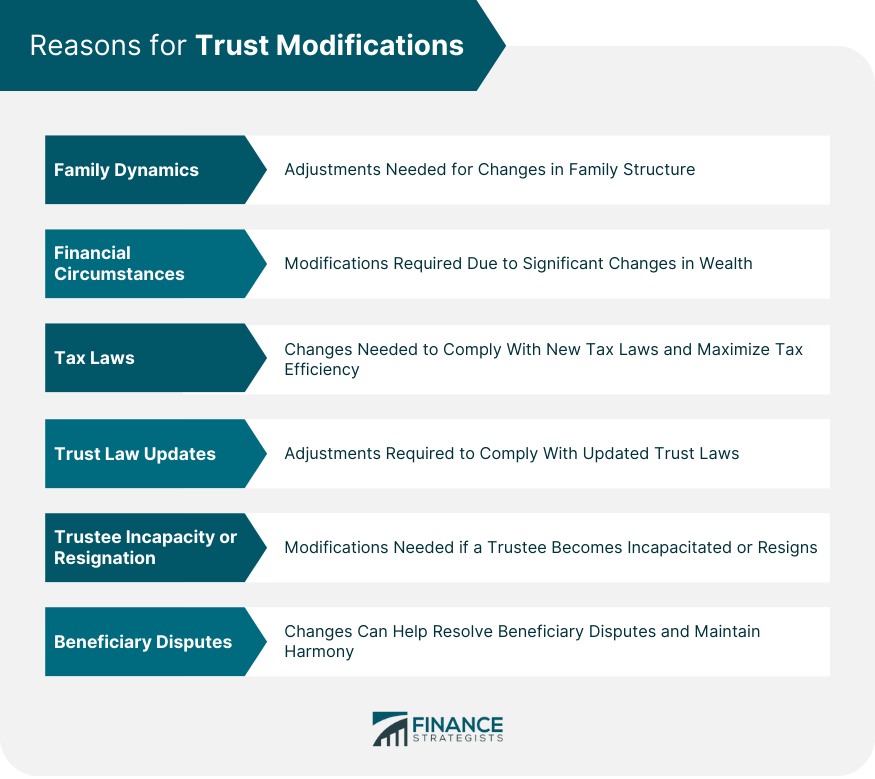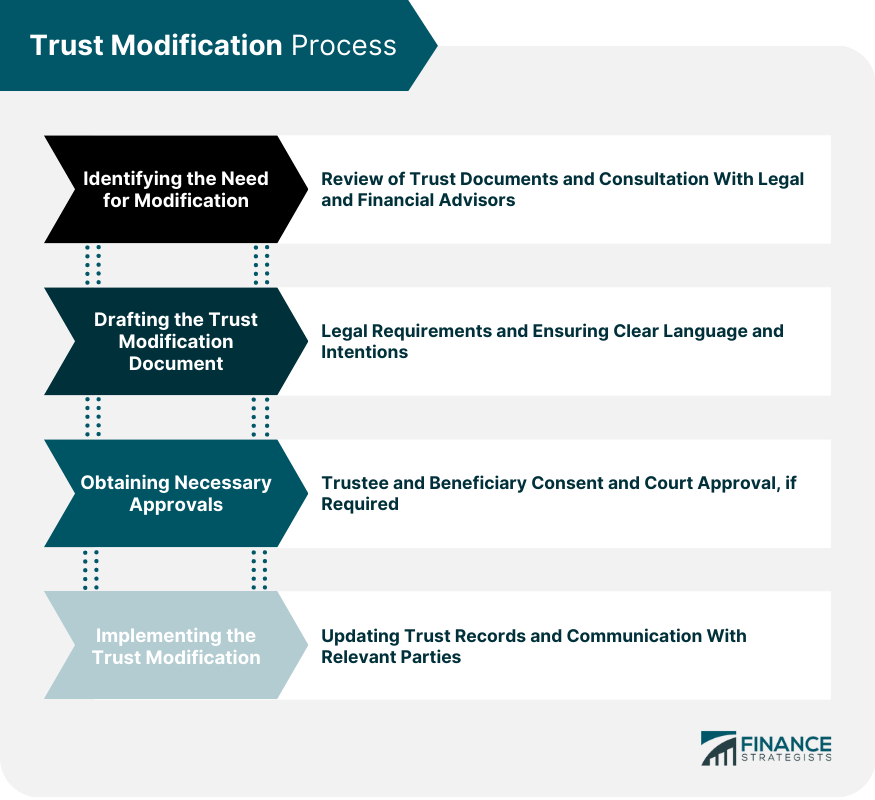Trust modification refers to the process of making changes to an existing trust document to better align with the grantor's intent or adapt to changing circumstances. Modifications can range from simple amendments to more substantial revisions, depending on the trust's objectives and the beneficiaries' needs. Trust modification plays a vital role in estate planning, as it ensures that a trust remains effective and up-to-date in light of evolving personal, financial, or legal circumstances. By making necessary adjustments, trust modification helps maintain the long-term viability of trusts and their ability to support beneficiaries. Some reasons for considering trust modification include changes in family or financial circumstances, updates in tax or trust laws, and trust administration issues. These factors may necessitate updates to trust provisions or terms to maintain their effectiveness and achieve the grantor's objectives. The Uniform Trust Code (UTC) is a comprehensive model law that provides a legal framework for trust modification in many states. The UTC sets forth guidelines and procedures for modifying trusts, including provisions for consent-based modifications and court-approved changes. Each state has its own trust laws that govern trust modification, which may differ from the UTC or other state laws. Understanding the applicable state-specific trust laws is crucial for ensuring a successful trust modification and compliance with legal requirements. Revocable trusts, also known as living trusts, can be amended or revoked by the grantor during their lifetime. This flexibility makes trust modification relatively straightforward for revocable trusts, as the grantor retains control over the trust terms. Irrevocable trusts, once established, cannot be easily amended or revoked by the grantor. However, under certain circumstances and with appropriate consent or court approval, irrevocable trusts may also be subject to modification to address changing needs or conditions. One common method for modifying a trust is through the consent of the trustee and beneficiaries. This approach may involve negotiation and agreement among all parties to implement the desired changes while preserving the grantor's intent and protecting the beneficiaries' interests. In some cases, trust modification may require court approval, especially if the trust is irrevocable or if the proposed changes are substantial. Court-approved modifications ensure that the changes are consistent with the grantor's intent and do not violate legal requirements or public policy. Changes in family dynamics, such as marriage, divorce, births, or deaths, may necessitate trust modifications to reflect the new family structure. Adjusting the trust terms ensures that the trust continues to serve the grantor's objectives and support the beneficiaries' needs. Financial changes, such as significant increases or decreases in wealth, may also warrant trust modification. These adjustments can help maintain the trust's effectiveness in meeting the beneficiaries' needs and achieving the grantor's estate planning goals. Changes in tax laws may necessitate trust modification to maximize tax efficiency and ensure compliance with new regulations. Adapting the trust terms to align with current tax laws can help preserve the trust's financial benefits and protect the beneficiaries' interests. Updates to trust laws may also warrant trust modification, especially if new provisions or requirements impact the trust's effectiveness or administration. Adjusting the trust terms to comply with updated laws helps maintain its legal viability and avoid potential disputes or complications. Trust modification may be necessary if a trustee becomes incapacitated or resigns, as it ensures the proper administration of the trust. Changes can include appointing a successor trustee, updating trustee powers, or restructuring the trust's administration. In cases where beneficiary disputes arise, trust modification can help resolve conflicts and clarify trust terms. This process can promote harmony among beneficiaries and ensure the trust continues to serve its intended purpose. The first step in the trust modification process is to review the trust documents to identify outdated or problematic provisions. This examination helps determine the necessary changes to ensure the trust remains effective and aligned with the grantor's objectives. Consulting with legal and financial advisors is crucial for identifying the need for trust modification, as they can provide expert guidance on potential changes and their implications. These professionals can help evaluate the trust's effectiveness and recommend modifications based on legal, tax, and financial considerations. When drafting the trust modification document, it's essential to adhere to legal requirements and ensure compliance with applicable trust laws. This process includes incorporating the necessary changes while preserving the grantor's intent and protecting the beneficiaries' interests. In the trust modification document, it's crucial to use clear language and explicitly state the intentions behind the changes. This clarity helps avoid ambiguities, misinterpretations, and disputes among trustees, beneficiaries, and other parties involved. Obtaining the consent of trustees and beneficiaries is often a critical step in the trust modification process, as it helps ensure agreement and support for the proposed changes. This consent can help avoid disputes, promote harmony among parties, and facilitate a smoother modification process. In cases where court approval is required for trust modification, the parties involved must petition the court and present the proposed changes. The court's approval helps ensure that the modifications are consistent with the grantor's intent and comply with legal requirements. Once the trust modification is complete, it's essential to update trust records to reflect the changes accurately. This process involves updating the trust document, amending related legal and financial documents, and ensuring all parties have access to the updated information. Communicating the trust modification to all relevant parties, such as trustees, beneficiaries, and financial institutions, is crucial for ensuring awareness and understanding of the changes. Clear and timely communication can help avoid confusion and facilitate a smooth transition. Legal disputes and challenges may arise from disagreements over the interpretation of trust terms, especially during the trust modification process. Ensuring clear language and well-defined intentions in the modification document can help minimize the risk of disputes. Trustee or beneficiary objections to the proposed trust modifications can lead to conflicts and legal challenges. Obtaining consent and addressing concerns during the modification process can help prevent disputes and maintain harmony among parties involved. Trust modifications may have federal and state tax consequences that affect the trust's financial benefits and the beneficiaries' interests. Understanding these potential tax implications before implementing trust modifications is essential to preserve tax efficiency and avoid unintended consequences. In some cases, trust modifications may inadvertently result in the loss of certain tax benefits, such as estate tax exemptions or income tax deductions. Consulting with tax and legal professionals during the modification process can help minimize the risk of losing these benefits and ensure compliance with tax laws. Unintended consequences may arise from trust modifications that negatively impact the trust's objectives or the grantor's original intent. Careful planning, clear communication, and expert guidance can help prevent such consequences and ensure the trust continues to serve its intended purpose. Misunderstandings or miscommunications during the trust modification process can lead to disputes or unintended results. Clear language in the modification document, open communication among all parties, and professional guidance can help mitigate these risks and facilitate a successful modification. Trust modification is an essential tool for adapting to changing circumstances, but it requires careful planning and expert guidance to ensure a successful outcome. Consulting with legal and financial professionals can help navigate the modification process, avoid potential pitfalls, and protect the grantor's intent and beneficiaries' interests. In estate planning, trust modification offers flexibility and adaptability, allowing trusts to remain effective and responsive to evolving needs and circumstances. By identifying the need for modification and implementing the appropriate changes, trust modification can help maintain the trust's long-term viability and support for beneficiaries. Trust modification strikes a balance between flexibility and protection, allowing for necessary adjustments while preserving the trust's overall purpose and structure. Through careful planning, consultation with experts, and adherence to legal requirements, trust modification can be an invaluable tool in estate planning and the ongoing administration of trusts.What Is a Trust Modification?
Legal Framework for Trust Modifications
Trust Modification Laws and Regulations
Uniform Trust Code (UTC)
State-Specific Trust Laws
Types of Trusts Subject to Modification
Revocable Trusts
Irrevocable Trusts
Modification Methods and Restrictions
Trustee and Beneficiary Consent
Court-Approved Modifications
Reasons for Trust Modifications
Change in Circumstances
Family Dynamics
Financial Circumstances
Legal or Regulatory Changes
Tax Laws
Trust Law Updates
Trust Administration Issues
Trustee Incapacity or Resignation
Beneficiary Disputes

Trust Modification Process
Identifying the Need for Modification
Review of Trust Documents
Consultation With Legal and Financial Advisors
Drafting the Trust Modification Document
Legal Requirements
Ensuring Clear Language and Intentions
Obtaining Necessary Approvals
Trustee and Beneficiary Consent
Court Approval, if Required
Implementing the Trust Modification
Updating Trust Records
Communication With Relevant Parties

Potential Risks and Challenges of Trust Modifications
Legal Disputes and Challenges
Interpretation of Trust Terms
Trustee or Beneficiary Objections
Tax Implications
Federal and State Tax Consequences
Potential Loss of Tax Benefits
Unintended Consequences
Impact on Trust Objectives
Misunderstandings or Miscommunications
Final Thoughts
Trust Modification FAQs
Trust modification refers to the process of making changes to an existing trust document to better align with the grantor's intent or adapt to changing circumstances. It is important in estate planning because it ensures the trust remains effective, up-to-date, and responsive to evolving personal, financial, or legal situations.
Yes, under certain circumstances and with appropriate consent or court approval, irrevocable trusts can also be subject to modification. This allows for adjustments that address changing needs or conditions while still maintaining the trust's overall purpose and structure.
Some common reasons for trust modification include changes in family or financial circumstances, updates in tax or trust laws, and trust administration issues such as trustee incapacity, resignation, or beneficiary disputes. These factors may necessitate updates to trust provisions or terms to maintain their effectiveness and achieve the grantor's objectives.
The trust modification process typically involves identifying the need for modification through reviewing trust documents and consulting with legal and financial advisors, drafting the trust modification document while adhering to legal requirements and ensuring clear language and intentions, obtaining necessary approvals from trustees, beneficiaries, and potentially the court, and implementing the trust modification by updating trust records and communicating with relevant parties.
Potential risks and challenges of trust modification include legal disputes and challenges related to interpretation of trust terms or trustee/beneficiary objections, tax implications such as federal and state tax consequences or potential loss of tax benefits, and unintended consequences that may impact trust objectives or result from misunderstandings or miscommunications. Careful planning, expert guidance, and clear communication can help mitigate these risks and ensure a successful trust modification.
True Tamplin is a published author, public speaker, CEO of UpDigital, and founder of Finance Strategists.
True is a Certified Educator in Personal Finance (CEPF®), author of The Handy Financial Ratios Guide, a member of the Society for Advancing Business Editing and Writing, contributes to his financial education site, Finance Strategists, and has spoken to various financial communities such as the CFA Institute, as well as university students like his Alma mater, Biola University, where he received a bachelor of science in business and data analytics.
To learn more about True, visit his personal website or view his author profiles on Amazon, Nasdaq and Forbes.











